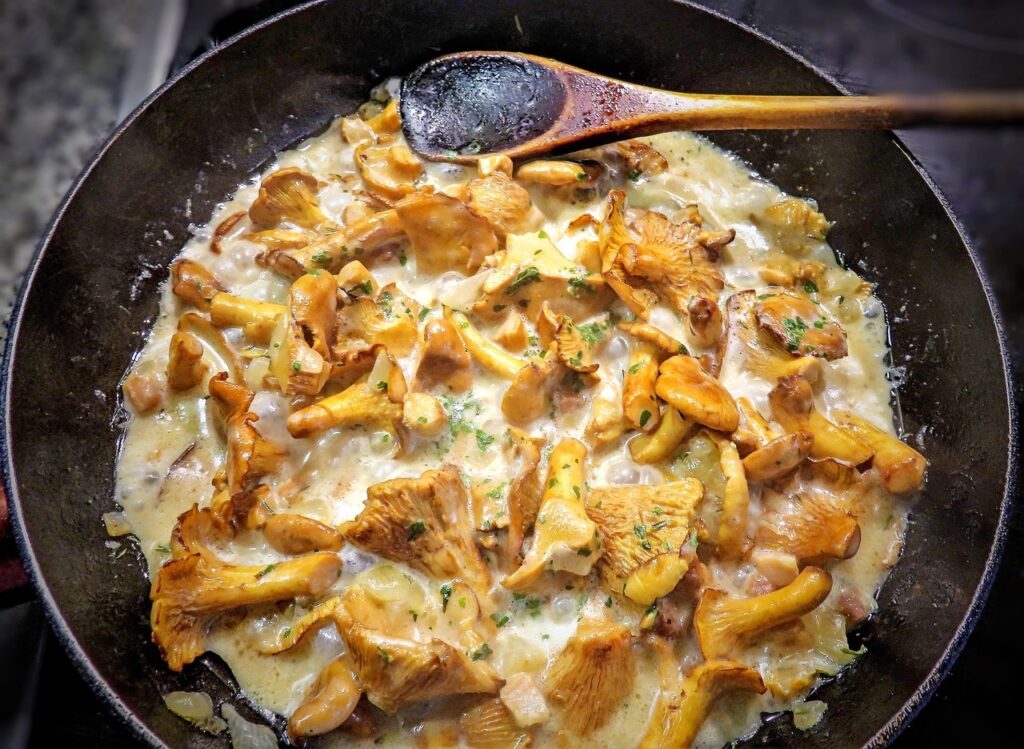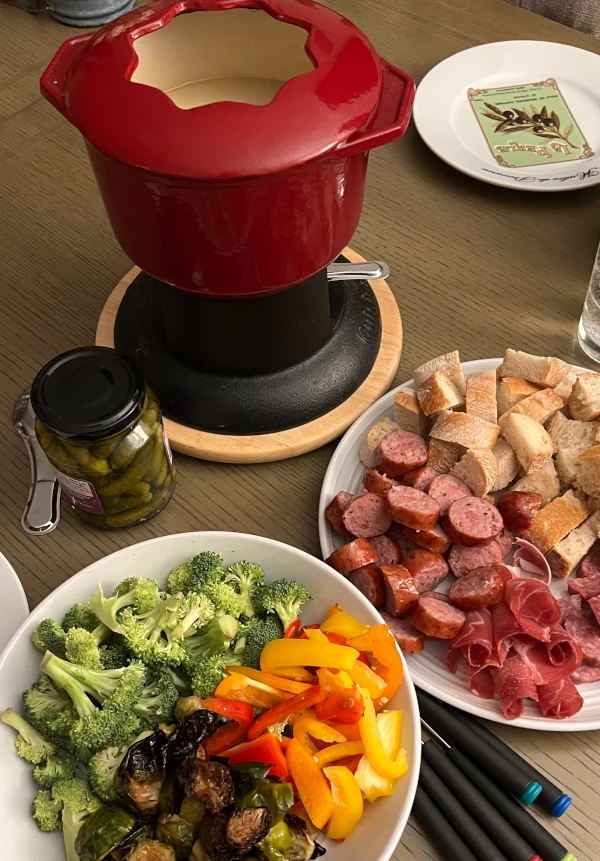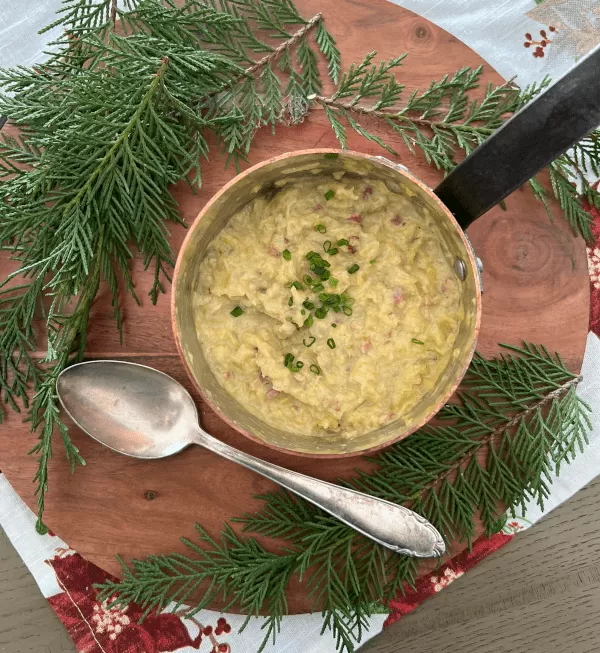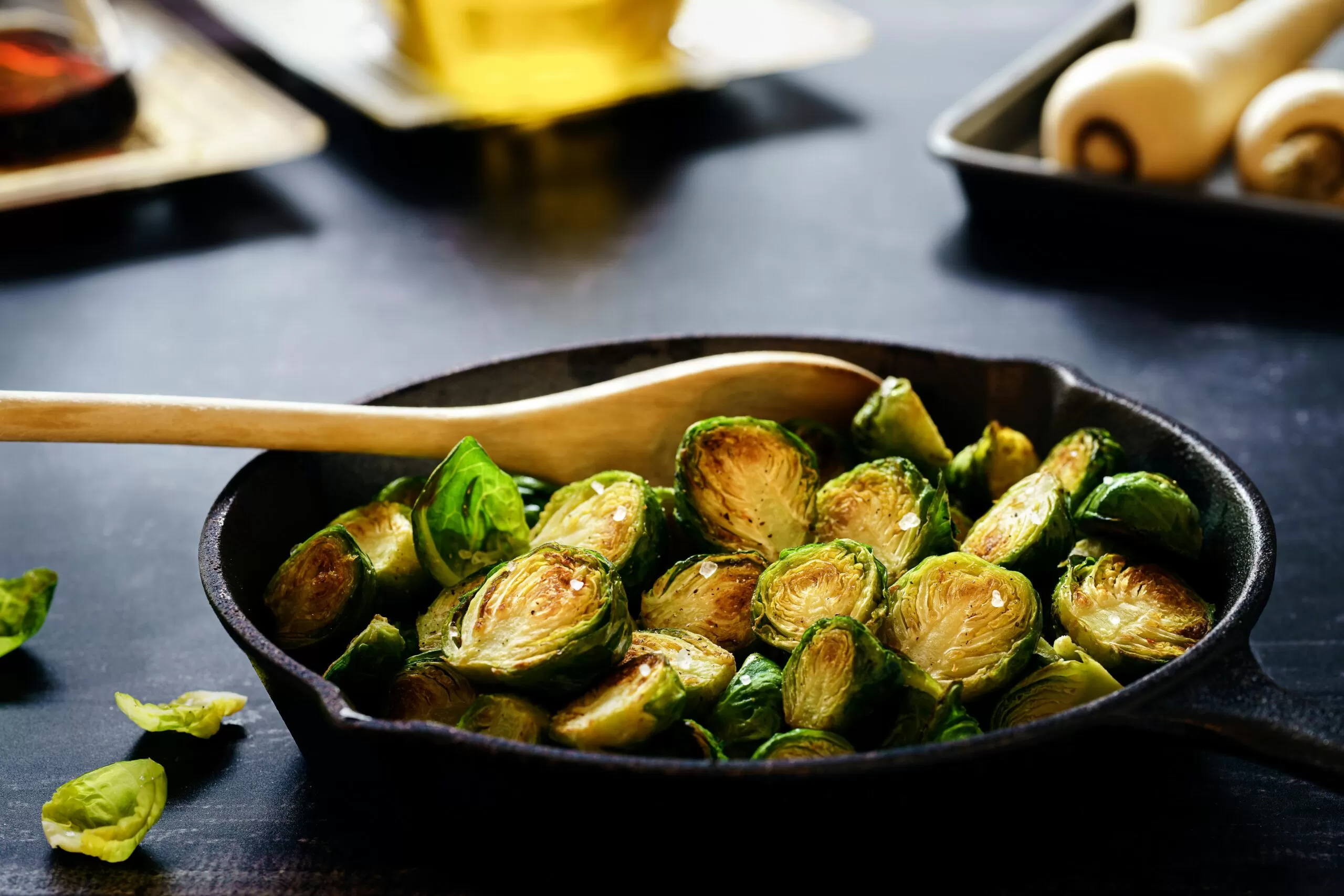Rahmschwammerl: A Forager’s Delight
Foraging for mushrooms is a passion that has been deeply rooted in my life since I was a child. The thrill of walking through the woods, the earthy scent of damp soil and decaying leaves underfoot, and the moment of discovery when you spot a cluster of golden chanterelles peeking out from the forest floor—these are experiences that bring me immense joy and satisfaction. Growing up in Pennsylvania, I spent countless summers and falls scouring the woods for these little treasures. It’s a tradition that connects me to the land, to my heritage, and to a culinary culture that values fresh, seasonal ingredients.

In Germany and much of Europe, foraging isn’t just a hobby; it’s a cherished pastime that spans generations. Families head into the woods together, baskets in hand, searching for mushrooms, berries, and other wild edibles. It’s a way of life that reflects a deep respect for nature and a desire to connect with the world around us. During my time living and working in Germany, I embraced this tradition wholeheartedly. I found myself spending weekends in the forests, often accompanied by friends or fellow chefs, gathering chanterelles, porcini, and other wild mushrooms that would later become the star ingredients in our kitchens.
One of my favorite recipes to make with the mushrooms I collect is Rahmschwammerl. This creamy mushroom dish is a classic in Bavarian cuisine, and it’s one that I’ve made countless times, both at home and in professional kitchens. The beauty of Rahmschwammerl lies in its simplicity. It’s a dish that allows the natural flavors of the mushrooms to shine, enhanced by just a few carefully chosen ingredients.
At Brauhaus Schmitz and the Reading Liederkranz, Rahmschwammerl was a special dish that we served occasionally, usually when the mushroom season was at its peak. It was always well-received by our guests, especially those who appreciated the delicate, earthy flavor of fresh chanterelles. This dish holds a special place in my heart because it represents the culmination of my foraging efforts—bringing the fruits of my labor into the kitchen and transforming them into something truly delicious.
The key to a good Rahmschwammerl is, of course, the mushrooms. Chanterelles are my top choice for this dish. They have a slightly peppery, fruity flavor that pairs perfectly with the creamy sauce. However, if chanterelles are hard to find, oyster mushrooms make an excellent substitute. They have a similar texture and a mild, savory taste that works beautifully in this recipe.
Here’s how I prepare Rahmschwammerl:
Ingredients:
- Chanterelles (or oyster mushrooms), cleaned and roughly chopped
- Onions, finely chopped
- Garlic, minced
- White wine (a dry variety works best)
- Vegetable broth
- Heavy cream
- Fresh thyme
- Salt and pepper to taste
- Fresh parsley for garnish
- Bread dumplings or spaetzle for serving (you can find my recipes for bread dumplings and spaetzle here)
Instructions:
- Sauté the Mushrooms: Start by heating a generous amount of butter in a large pan over medium heat. Once the butter has melted and is sizzling, add the chopped onions and garlic. Sauté them until they are soft and translucent, being careful not to let them brown.
- Add the Mushrooms: Increase the heat slightly and add the chanterelles or oyster mushrooms to the pan. Cook them for several minutes, allowing them to release their moisture and begin to caramelize. This step is crucial as it intensifies the flavor of the mushrooms.
- Deglaze with White Wine: Once the mushrooms have a nice golden color, pour in the white wine to deglaze the pan. The wine will pick up all those delicious browned bits stuck to the bottom of the pan, adding depth to the sauce. Let the wine simmer for a couple of minutes until it has reduced slightly.
- Add Vegetable Broth and Thyme: Next, pour in the vegetable broth and add a few sprigs of fresh thyme. Let the mixture simmer gently for about 10 minutes, allowing the flavors to meld together.
- Finish with Cream: After the broth has reduced and the mushrooms are fully cooked, stir in the heavy cream. Reduce the heat to low and let the sauce thicken for a few minutes. Season with salt and pepper to taste.
- Serve: Rahmschwammerl is traditionally served over bread dumplings or spaetzle. The dumplings soak up the creamy sauce beautifully, making every bite a comforting, savory delight. If you’re gluten-free, this sauce pairs wonderfully with gluten-free pasta or even over a bed of mashed potatoes.
- Garnish: Finish the dish with a sprinkle of fresh parsley. It adds a touch of color and a burst of freshness that complements the rich, creamy sauce.
What I love most about Rahmschwammerl is its versatility. While it’s often enjoyed as a main course in Bavaria, it can also be served as a side dish alongside roast meats or as an elegant starter. The creamy mushroom sauce is naturally gluten-free, making it a great option for those with dietary restrictions. And because it’s vegetarian, it appeals to a wide audience.
When I make Rahmschwammerl, I always feel a sense of connection—to the forests where I found the mushrooms, to the kitchens where I’ve cooked this dish, and to the people who have enjoyed it over the years. It’s a dish that embodies the spirit of foraging: taking what nature provides and turning it into something nourishing and delicious.
The tradition of foraging is something I hold dear, and it’s one that I believe more people should experience. There’s something incredibly satisfying about gathering your own food, whether it’s mushrooms from the forest, herbs from the garden, or vegetables from a local farm. It’s a way of reconnecting with the natural world and understanding where our food comes from.
In Germany, foraging is more than just a way to gather food—it’s a cultural practice that brings people together. In many rural areas, you’ll find foraging clubs where members meet regularly to explore the woods and fields, sharing tips on where to find the best mushrooms or berries. It’s a social activity that fosters a sense of community and a deep appreciation for the land.
During my time in Germany, I was fortunate enough to join some of these foraging excursions. It was a great way to learn from experienced foragers and to discover new spots where mushrooms were abundant. But more than that, it was an opportunity to connect with others who shared my passion for good food and the great outdoors.
The foraging culture in Europe is something that I wish we had more of in the United States. While foraging is certainly gaining popularity here, it still isn’t as widespread or as deeply ingrained in our culinary traditions. But there’s hope. As more people become interested in sustainability, local food, and natural living, I think we’ll see a resurgence in the popularity of foraging.
One of the things I always emphasize when talking about foraging is the importance of knowing what you’re doing. Mushroom foraging, in particular, requires a certain level of knowledge and expertise. There are many edible mushrooms in the wild, but there are also many that are toxic, and sometimes the differences are subtle. If you’re new to foraging, I highly recommend going out with an experienced guide or joining a foraging group. They can teach you how to identify different species and help you avoid any dangerous mistakes.
When it comes to chanterelles, they’re one of the easier mushrooms to identify, which makes them a great starting point for novice foragers. They have a distinctive golden-yellow color, a fruity smell reminiscent of apricots, and gill-like ridges on the underside of their caps that run down the stem. Once you’ve identified a few chanterelle patches, you’ll likely find them in the same spot year after year, as long as the conditions are right.
In the kitchen, chanterelles are incredibly versatile. Their delicate flavor and firm texture make them a perfect addition to a wide variety of dishes, from soups and stews to pastas and risottos. But Rahmschwammerl is where they truly shine, in my opinion. The creamy sauce enhances their natural flavor without overpowering it, allowing the essence of the mushrooms to take center stage.
As a chef, one of the most rewarding experiences is taking an ingredient that you’ve harvested yourself and transforming it into a dish that others can enjoy. Rahmschwammerl is one of those dishes for me—a labor of love that reflects my passion for foraging, my respect for traditional Bavarian cuisine, and my desire to share these experiences with others.
So the next time you find yourself in the woods during mushroom season, keep an eye out for those golden chanterelles. With a little luck and a lot of patience, you might just find enough to make a batch of Rahmschwammerl at home. And trust me, it’s worth every minute you spend in the forest.
In closing, I hope this recipe inspires you to get out and explore the world of foraging, whether you’re a seasoned forager or just starting out. There’s a whole world of flavors waiting to be discovered in the woods, and Rahmschwammerl is just one way to enjoy the bounty that nature provides. Happy foraging!
Note: If you’re interested in trying this dish at home, be sure to check out my bread dumpling and spaetzle recipes, both of which pair beautifully with Rahmschwammerl. And if you’re gluten-free, feel free to serve the creamy mushroom sauce over your favorite gluten-free substitute—it’s just as delicious!
Frequently Asked Questions (FAQ) about Rahmschwammerl
1. Can I use other types of mushrooms if I can’t find chanterelles or oyster mushrooms?
Yes, you can definitely use other types of mushrooms if chanterelles or oyster mushrooms are unavailable. Cremini or button mushrooms are more commonly found and work well in this dish. While the flavor might be slightly different, the creamy sauce will still complement the mushrooms beautifully. Just remember that the unique flavor of chanterelles is what makes this dish special, so if you can find them, it’s worth it!
2. Is Rahmschwammerl gluten-free?
Yes, the sauce for Rahmschwammerl is naturally gluten-free. The creamy mushroom sauce is made without any flour or gluten-containing thickeners. If you’re gluten-free, you can serve the sauce over gluten-free pasta, mashed potatoes, or a gluten-free bread dumpling. It’s a versatile dish that can easily accommodate different dietary needs.
3. Can I make Rahmschwammerl ahead of time?
Rahmschwammerl can be made ahead of time, but for the best flavor and texture, I recommend serving it fresh. If you do need to make it in advance, prepare the sauce and mushrooms, then store them in the refrigerator for up to a day. When you’re ready to serve, gently reheat the dish on the stovetop, adding a little extra cream or vegetable broth if needed to loosen the sauce. Be careful not to overcook the mushrooms during reheating, as they can become rubbery.
4. What are the best side dishes to serve with Rahmschwammerl?
Rahmschwammerl is traditionally served over bread dumplings (Semmelknödel) or spaetzle, both of which soak up the creamy sauce beautifully. You can also serve it with mashed potatoes, rice, or even polenta if you’re looking for something different. A simple green salad or steamed vegetables like green beans or asparagus make a great accompaniment to balance the richness of the dish.
5. How should I store leftovers, and how long will they keep?
If you have leftovers, store them in an airtight container in the refrigerator. Rahmschwammerl will keep for about 2-3 days. When reheating, do so gently on the stovetop over low heat, adding a splash of cream or broth to help bring the sauce back to its original consistency. Avoid using the microwave, as it can cause the mushrooms to become rubbery and the sauce to separate.





2 thoughts on “Rahmschwammerl – Creamy Mushrooms”
Good morning Jeremy! Beautiful site!
I tried to print out the recipe but the print button did not work. Possibly my phone, although I print a lot from it.
All the best to you and the family!
Eric
Hey Eric!
Thanks for letting us know. I can’t see anything wrong on our end. Try again and let me know, it should work.
-Jeremy